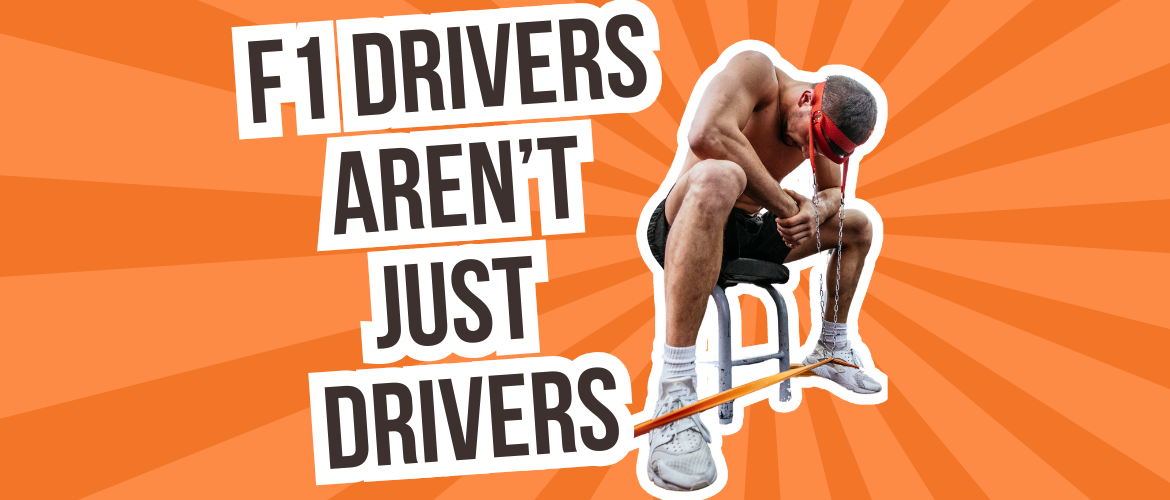GET IN TOUCH TODAY!
"*" indicates required fields

If you’re a personal trainer looking to step into the world of strength and conditioning (S&C), one skill you’ll need to master is athlete profiling. It’s the foundation of designing effective, evidence-based programmes for athletes. To bring this to life, let’s take a look at one of the most demanding and globally recognised sports—Formula 1 racing.
While Formula 1 drivers might not look like your typical power athlete, their performance depends on precise physical, physiological, and psychological preparation. Profiling helps coaches understand exactly what those demands are and how to build training programmes that transfer directly to performance.
Athlete profiling is more than just testing fitness. It’s about systematically identifying the key demands of the sport, the athlete’s baseline capabilities, and the gap between the two.
For a Formula 1 driver, profiling answers questions like:
How much aerobic capacity do they need to sustain 90 minutes of high-intensity racing?
How strong must their neck be to resist 6.5G in corners?
How fast must their reaction time be to respond to split-second track events?
Without profiling, programme design risks becoming generic. And in elite sport—where milliseconds matter—generic is the enemy of performance.
F1 is a perfect example because it combines endurance, strength, and cognitive performance under extreme stress:
Aerobic fitness: Drivers sustain heart rates at 65–85% HRmax, burning up to 1,000 kcal per hour.
Neck and core strength: Lateral neck flexion must withstand G-forces equivalent to five times bodyweight.
Grip endurance: Steering requires constant forearm strength, with elite drivers showing grip scores >55 kg.
Reaction time: 150–200 ms, far quicker than the average person’s 250–300 ms.
Anthropometry: Lean builds (~8% body fat, ~65–70 kg) to meet strict cockpit weight regulations.
By understanding these demands, S&C coaches can target the exact qualities needed rather than wasting time on irrelevant exercises.
For S&C coaches, testing must be relevant, valid, and repeatable. An F1 test battery might include:
VO₂max testing – to monitor aerobic capacity.
Isometric neck dynamometry – to measure neck strength.
Handgrip dynamometry – for grip strength and endurance.
Knee extension isometrics – linked to braking power.
Reaction time drills – e.g., Batak board or FitLight.
The results give you baseline data to compare against normative values and elite standards. From there, you set targets and track progress.
Profiling data feeds directly into goal setting. For example:
Short-term goal: Improve handgrip endurance by 10% over 4 weeks.
Medium-term goal: Increase isometric neck strength by 15% in 12 weeks.
Long-term goal: Maintain VO₂max >60 ml·kg⁻¹·min⁻¹ and body fat <10% across the season.
These goals are specific, measurable, and performance-focused. They also ensure both the athlete and coach know what success looks like.
Using the F1 profile, an S&C coach might prescribe:
Neck isometrics against bands or harnesses to build race-specific strength.
Grip endurance work like farmer’s carries, hangs, and wrist rollers.
Aerobic conditioning using HIIT and steady-state training on cycling ergometers.
Core stability drills (anti-rotation and anti-flexion holds).
Strength training for knee extensors to maximise braking power.
Delivery should also reflect environmental stressors—heat acclimation, cockpit simulations, and cognitive tasks under fatigue all prepare the driver for race-day reality.
Elite sport is never a one-person show. Profiling highlights where collaboration is needed:
Physiotherapists for injury prevention.
Nutritionists to manage weight and hydration.
Psychologists to support cognitive performance.
Engineers to optimise cockpit ergonomics.
As an aspiring S&C coach, being able to communicate your profiling findings to a multidisciplinary team makes you invaluable.
Finally, profiling isn’t a one-off. It’s a cycle. Test, programme, deliver, evaluate, repeat. Regular re-testing against normative and elite benchmarks ensures progress is being made and the programme stays aligned with competition demands.
Heart Rate & HRV: Continuous monitoring shows training load, recovery status, and readiness to perform. HRV can flag fatigue or overtraining risk.
GPS & Accelerometry: While less relevant on-track, wearables in training (cycling ergometers, resistance devices, IMUs) measure workload, power output, and movement efficiency.
Grip & Force Sensors: Smart steering wheels and handgrip sensors can track grip fatigue and neuromuscular endurance during simulations.
Core & Skin Temperature Sensors: Essential for monitoring heat stress in cockpit-like conditions.
Sleep & Recovery Data: Wearables track sleep quality, duration, and recovery, helping S&C coaches adjust training load.
Data Integration: By comparing wearable data with test battery results, coaches can see whether physical gains (e.g., VO₂max or knee extensor strength) actually transfer to race performance.
Practical Use: For a Formula 1 driver, wearables allow coaches to evaluate how neck and leg strength endure across repeated laps, whether grip fatigue appears earlier than expected, or if cardiovascular strain exceeds training benchmarks. This enables real-time adjustments to training programmes and supports evidence-based communication with the wider multidisciplinary team.
For PTs wanting to break into S&C, the Formula 1 example shows why athlete profiling is a non-negotiable skill. Whether you’re working with a racing driver, footballer, or sprinter, the principles are the same:
Understand the sport’s demands.
Assess the athlete’s current profile.
Bridge the gap with targeted training.
It’s this structured, scientific approach that separates an S&C coach from a personal trainer.
If you’re serious about progressing from PT to S&C coach, start by learning profiling frameworks and practice designing sport-specific test batteries. Formula 1 drivers might be a unique case, but the lesson is universal: profiling drives performance.
Ready to upskill? Check out our Level 4 Strength & Conditioning Course, designed to take you from personal trainer to performance coach.
Starting from scratch? Our Elite Personal Training Package gives you everything you need to qualify and build your career in fitness.
Not sure where to start? Fill out the form below and we’ll guide you through your options and help you map the best route forward.
"*" indicates required fields